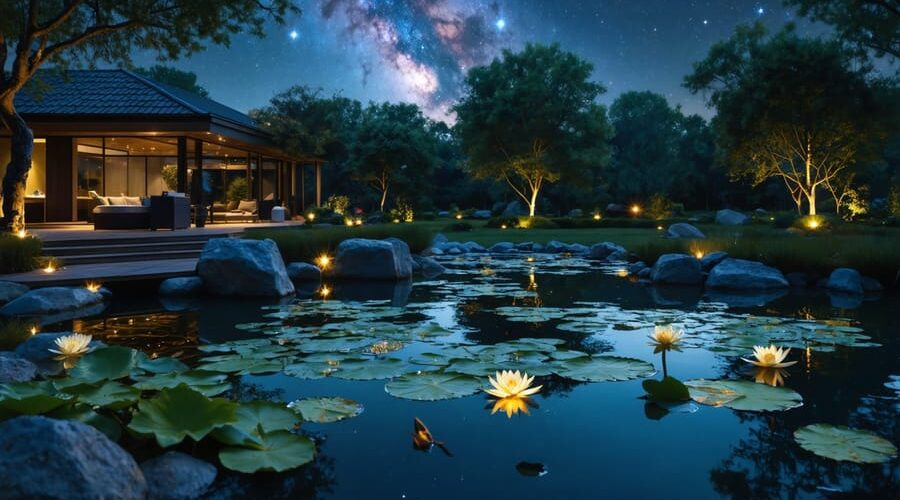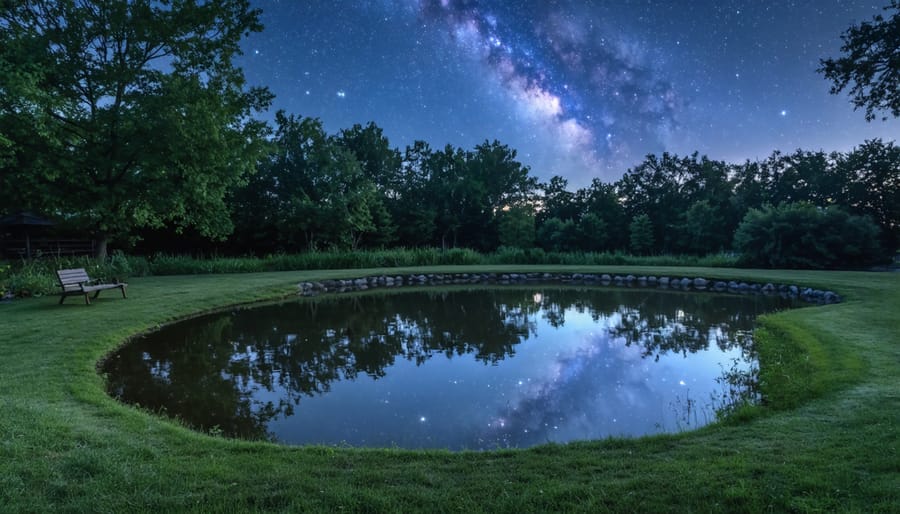
Your Pond Just Became the Perfect Stargazing Sanctuary
**Map your backyard’s current light levels using a free sky quality meter app on your smartphone**—these tools measure brightness in magnitudes per square arcsecond, with readings above 20 indicating excellent dark sky conditions. Most suburban yards sit between 17-19, but strategic lighting changes around your pond can push you into true stargazing territory.
**Replace existing pond lights with warm amber LEDs rated at 2700K or lower**, which minimize blue light spectrum pollution that disrupts both night vision and aquatic ecosystems. Position fixtures downward at 45-degree angles, illuminating only water features rather than flooding the entire yard with upward scatter.
**Create designated dark zones by installing motion sensors on pathway lights**, ensuring they activate only when needed rather than maintaining constant brightness. This approach transforms your water garden into a genuine astronomical observation point while maintaining safety—you’ll be surprised how quickly your eyes adapt to natural darkness around your pond’s edge.
**Shield all remaining outdoor lighting with purpose-built baffles or DIY cardboard templates**, directing every lumen exactly where it’s needed. When I first converted my own pond area using these techniques, the Milky Way appeared within three weeks—a sight I hadn’t witnessed from home in fifteen years.
The secret isn’t finding remote wilderness; it’s engineering your own nighttime pond retreat where stars reflect off still water. Your backyard already has the potential—it just needs the right lighting approach to unlock celestial views that rival dedicated dark sky parks.
Why Your Pond Makes Stargazing Even Better
Your backyard pond isn’t just beautiful during the day—it transforms into something truly magical when the sun goes down. If you’re serious about reducing light pollution and enjoying incredible stargazing, you’ve already got a secret weapon right outside your door.
Here’s what makes ponds and night skies such a perfect match: water acts like nature’s mirror. When you position yourself near your pond on a clear night, you’re essentially doubling the view. The stars above reflect on the water’s surface below, creating this breathtaking, almost surreal experience where you’re surrounded by constellations. I’ll never forget the first time I caught the Big Dipper both overhead and shimmering in my pond—it felt like being suspended in space.
The gentle sounds of water features add another dimension to stargazing that most people overlook. Whether it’s a small fountain bubbling or a waterfall trickling, these calming sounds mask neighborhood noise and help you fully disconnect. There’s something about combining the visual wonder of the cosmos with the peaceful soundtrack of moving water that makes the whole experience deeply meditative.
Your pond also naturally draws you outside in the evening. Instead of scrolling through your phone indoors, you’ll find yourself wandering out to check on your fish or water plants—and suddenly you’re looking up. It creates this wonderful ritual, a natural focal point for unwinding after a long day.
The best part? You don’t need to drive anywhere or plan elaborate trips. Your personal observatory is just steps away, combining your passion for water gardening with the awe-inspiring beauty of a truly dark sky.

Finding Your Light Pollution Level (And What It Means for You)
Quick Ways to Check Your Night Sky Quality
You don’t need fancy equipment to assess your backyard’s light pollution—let’s start with the simplest method! On a clear night, step outside about 30 minutes after sunset and look up. Can you see the Milky Way? If yes, congratulations—you’re already in a dark sky zone! Count the stars in a small section of sky; if you spot fewer than 10, you’ve got moderate to heavy light pollution.
For a more precise reading, download free apps like “Dark Sky Finder” or “Loss of the Night.” These smartphone tools measure sky brightness and give you a light pollution rating right from your pond area. I love using these while sitting by my water garden—it’s become a peaceful evening ritual!
Websites like lightpollutionmap.info let you zoom into your exact address and see color-coded light pollution levels. The darker the color on the map, the better your stargazing potential.
Here’s my favorite test: try spotting the constellation Ursa Minor (Little Dipper). If you can see all seven stars clearly, your backyard sky quality is excellent for both stargazing and creating that magical, naturally-lit pond atmosphere we’re aiming for!
What You’ll Actually See at Different Light Levels
In a suburban backyard with moderate light pollution, you’ll easily spot bright planets like Venus, Jupiter, and Mars, plus major constellations like Orion and the Big Dipper. The brighter stars become your friends, and on good nights, you might catch 50-100 stars total. It’s honestly more than most people expect once they actually look up!
Move to a semi-rural setting with your pond, and things get exciting. You’ll see the Milky Way as a faint cloudy band stretching across the sky, hundreds of stars filling familiar constellations, and satellites slowly gliding overhead. I remember the first time I saw the Milky Way reflected in my pond—absolutely magical.
In truly rural areas with minimal light pollution, prepare to be amazed. Thousands of stars become visible, the Milky Way shows stunning detail and structure, meteor showers deliver frequent “shooting stars,” and you might even spot the Andromeda Galaxy with your naked eye. Your pond becomes a perfect mirror for this celestial show, doubling the wonder. The key is managing your own lighting—even in darker areas, one poorly placed floodlight can ruin everything you’ve worked to achieve.
Taming the Light Around Your Pond
Choosing Stargazing-Friendly Pond Lighting
When I first tried stargazing beside my pond, I made the mistake of installing bright white LED path lights—it was like trying to see the Milky Way while standing next to a car dealership! Your eyes need about 20-30 minutes to fully adapt to darkness, and traditional lighting ruins that instantly.
The secret is switching to red spectrum lighting. Red lights preserve your night vision because your eye’s rod cells (the ones that help you see in darkness) are far less sensitive to red wavelengths. I now use red LED bulbs in my pathway fixtures, and the difference is remarkable—I can safely navigate to my pond seating area without losing my dark-adapted vision.
Shielded fixtures are equally important. Light should point downward only, not scatter upward into the sky or across your yard. Look for fully-shielded or “full cutoff” fixtures that direct illumination exactly where you need it—on steps, walkways, or pond edges—without creating light trespass.
Motion sensors work beautifully for occasional access. Your pond lighting strategies should include sensor-activated lights that turn on only when you’re approaching, then automatically shut off after a few minutes. This gives you safe access without constant illumination.
Finally, install dimmer switches on any permanent lighting. On clear nights perfect for stargazing, dial everything down to the absolute minimum—just enough glow to prevent accidents. Your eyes will thank you, and the stars will truly shine.

Strategic Placement That Works for Fish and Stars
The secret to happy fish AND stellar stargazing? It’s all about thoughtful placement! I learned this the hard way when I first installed pond lights everywhere—my koi seemed stressed, and I couldn’t see the Milky Way from my favorite patio chair.
Here’s what actually works: Position low-wattage lights close to the waterline, angled *downward* toward the water surface rather than up into the sky. This illuminates your pond just enough for safety and viewing fish behavior without creating that upward glow that washes out stars. Think of it as creating a “light curtain” that stays near the ground.
Create intentional dark zones by keeping the northern side of your pond lighting-free—that’s where you’ll set up your stargazing spot. Use pathway lights with full shields or caps that prevent any light from escaping upward. I switched to amber or warm red LEDs (2700K or lower) around my pond’s edges, which provide visibility without disrupting my night vision or stressing the fish.
For areas requiring brighter light near the pond for safety, use motion sensors so they’re only on when needed. Your fish will appreciate the darkness during their rest periods, and you’ll be amazed how many more stars appear once you’ve stopped flooding your yard with unnecessary upward light.
Working With (or Around) Neighbor’s Lights
Sometimes the biggest obstacle to your backyard stargazing isn’t your own lights—it’s your neighbor’s security floodlight beaming straight into your pond area! Before anything else, have a friendly chat. Most neighbors don’t realize their lights are spilling over, and they’re often happy to adjust timers, redirect fixtures, or add motion sensors instead of keeping them on all night.
If conversation doesn’t solve it, get creative with physical barriers. I’ve had great success planting fast-growing bamboo or installing tall ornamental grasses along property lines—they look beautiful during the day and block horizontal light at night. Lattice screens covered with climbing vines like clematis serve double duty as privacy features and light blockers. For immediate results, position a strategically placed arbor or pergola between the offending light and your viewing spot. You can even arrange your pond seating to take advantage of natural barriers like your shed or garage. Sometimes simply relocating your stargazing chair ten feet makes all the difference in creating your own dark-sky sanctuary!
Creating Your Pondside Stargazing Spot
Best Seating and Setup for Long Viewing Sessions
For hours of comfortable stargazing, your setup makes all the difference! I’ve spent countless nights by my pond, and here’s what works beautifully: invest in a zero-gravity reclining chair or padded lounger that supports your neck without straining it skyward. Position your seating at least six feet from the pond’s edge to protect plants and prevent accidental tumbles in the dark.
Layer up with blankets even in summer—nights get surprisingly cool when you’re stationary. A waterproof ground cloth under your chair protects against dew-dampened grass while keeping moisture away from the pond margin where beneficial bacteria thrive.
Consider building a simple wooden viewing platform using weathered timber that blends naturally with your landscape. This elevates you slightly, improving your sight lines while defining a specific “astronomy zone” that keeps foot traffic away from delicate pond edges.
For peaceful pondside relaxation, face away from any unavoidable ambient light sources. Keep a small side table within arm’s reach for star charts, binoculars, and a thermos—you won’t want to interrupt your viewing by heading inside. Remember, comfort equals longer, more rewarding stargazing sessions!

Seasonal Considerations for Pond and Sky
Your backyard observatory transforms beautifully throughout the year, and timing your stargazing sessions with your pond’s natural rhythms makes everything easier. I’ve learned this the hard way—trying to adjust underwater lights during a January freeze isn’t fun!
Spring offers excellent viewing conditions as temperatures moderate and you’re already outside preparing your pond for the growing season. This is perfect timing to install or adjust lighting before plants fill in. The spring sky treats you to Leo, Virgo, and the spectacular Beehive Cluster, all visible without fancy equipment.
Summer brings warm, comfortable evenings but also peak pond maintenance activity. Schedule your filter cleanings and algae treatments for early morning hours, leaving evenings free for stargazing. The Milky Way arcs brilliantly overhead during summer months, and you can actually watch it reflect in your pond’s surface—absolutely magical. Keep insect zappers off, as their UV light ruins night vision and creates unnecessary light pollution.
Fall is my favorite season for pond-side astronomy. Cooler temperatures mean fewer bugs, clearer skies, and you’re transitioning pond lighting anyway as you prepare for winter. The Andromeda Galaxy becomes prominent, and meteor showers like the Perseids and Orionids put on spectacular shows.
Winter requires extra planning—protect equipment from moisture and have warm blankets ready—but rewards you with the clearest skies of the year. If you maintain open water for fish, position de-icers carefully to minimize light spillage, or switch to units without indicator lights.
Enhancing the Experience: Sound, Scent, and Reflection
Water Features That Soothe Without Disturbing
Water features add magic to any pond, but when you’re creating a stargazing sanctuary, you’ll want to be thoughtful about your choices. I learned this the hard way after installing a fountain with LED lights that basically turned my backyard into a disco!
The good news? Gentle water movement actually enhances nighttime relaxation without interfering with your dark sky views. Small bubbler fountains, simple spillways, or even a quiet waterfall create soothing sounds that mask distant noise while keeping light pollution at bay. The key is choosing features without built-in illumination or reflective surfaces that catch stray light.
Skip those pumps with integrated LED displays—they’re surprisingly bright at night. Instead, opt for submersible pumps without indicator lights, or cover any displays with black electrical tape (works like a charm). Position your water feature so gentle movement creates soft sounds rather than splashing that disturbs the peaceful atmosphere.
Consider solar-powered options that run during the day and naturally quiet down at dusk, giving you the best of both worlds—daytime beauty and nighttime tranquility perfect for stargazing.
Night-Blooming and Fragrant Pond Plants
Who says you need artificial lighting to enjoy your pond after sunset? Some of the most magical pond plants actually save their best performance for evening hours, naturally enhancing your dark-sky experience.
**Night-blooming tropical water lilies** are absolute showstoppers that open as the sun goes down. Varieties like ‘Red Flare’ and ‘Wood’s White Knight’ unfurl their spectacular blooms around dusk, staying open until mid-morning. I’ll never forget the first time I watched my ‘Maroon Beauty’ slowly open at twilight—it felt like witnessing something truly special. These beauties are white or pale-colored, making them visible even in low light conditions without needing spotlights.
For fragrance that draws you outside after dark, consider adding **four o’clock flowers** along your pond margins. They release their sweet scent precisely when you’re settling in for stargazing. **Night-blooming jasmine** planted near seating areas creates an intoxicating evening atmosphere.
**White-flowered marginal plants** like pickerel weed ‘Alba’ and white-flowering rush naturally reflect moonlight and starlight, creating gentle visual interest without competing with the night sky. They’re like nature’s own subtle accent lighting—beautiful, functional, and completely pollution-free.
Simple Stargazing Activities for Your Pond Nights
Starting your pondside stargazing journey doesn’t require expensive equipment or astronomy degrees—just curiosity and a comfortable spot by the water! Let me share some activities that have brought magic to my own pond nights.
**Moon Watching Made Easy**
Begin with the moon, your most reliable celestial companion. On clear nights, watch how moonlight dances across your pond’s surface, creating a natural mirror. Notice how the moon’s phase changes throughout the month—from thin crescent to full orb. Using a simple stargazing app on your phone, you can identify lunar features like craters and seas. I love sketching what I see; it’s amazing how much more you notice when you draw it.
**Constellation Hunting**
Start with the Big Dipper—it’s visible year-round in most locations and acts as your cosmic compass. Once you’ve spotted it, use it to find Polaris (the North Star). From there, let your eyes wander to discover Cassiopeia’s distinctive W-shape or Orion’s belt. Keep a constellation guide or app handy, but don’t stress about finding everything at once. Some nights, I simply lie back and enjoy the view without identifying a single star!
**Meteor Shower Nights**
Mark your calendar for major meteor showers like the Perseids (August) or Geminids (December). Your dark pond setting provides ideal viewing conditions. Bring a blanket, settle in, and give your eyes twenty minutes to adjust. The stillness perfect for nighttime wildlife viewing also makes spotting shooting stars easier—just stay patient and keep watching!
You’ve spent time crafting the perfect pond—balancing the ecosystem, selecting beautiful plants, creating inviting spaces around the water’s edge. Now you have the unique advantage that most stargazers can only dream about: complete control over your viewing environment. While others drive hours searching for dark sky locations, you can step into your backyard and experience the cosmos reflected in your own water.
The best part? You don’t need expensive equipment or major renovations to get started. Simple changes like switching to warm-toned path lights, adding shields to existing fixtures, or embracing a few hours of darkness each evening can dramatically improve your night sky views. Your pond already serves as a peaceful retreat during the day—why not extend that serenity into the evening hours?
Think of this as adding another layer to your water gardening hobby. Just as you’ve created a meditation sanctuary by the water, you’re now building a window to the universe. Start small: turn off your pond lights for one night this week and see what appears overhead. You might be surprised at what’s been hiding above you all along. The stars, planets, and moon have always been there—you’re simply giving yourself permission to notice them, all while sitting beside the tranquil water you’ve worked so hard to create.
